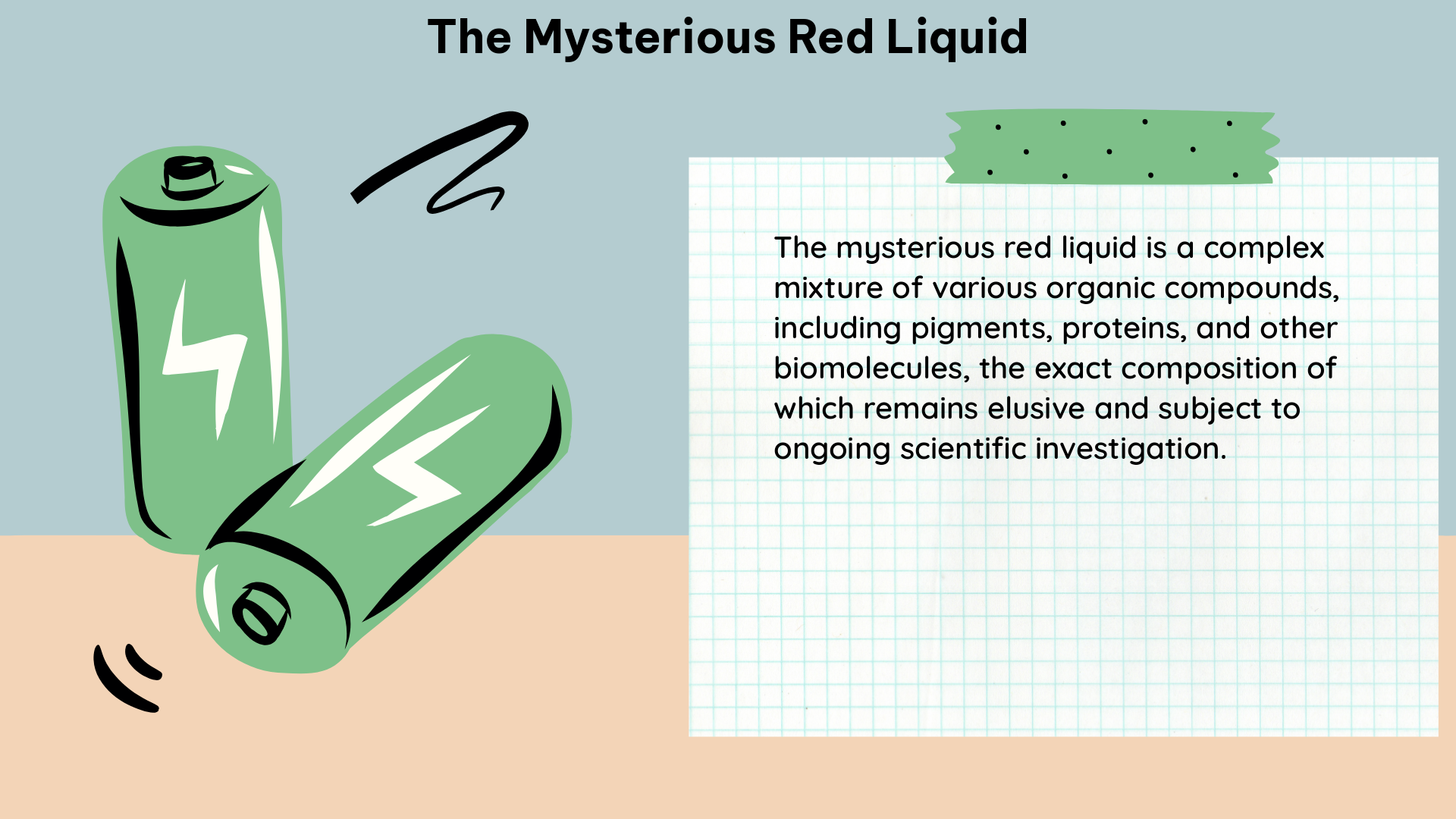The mysterious red liquid is a captivating substance that has piqued the interest of many due to its unique properties and potential applications. This comprehensive guide delves into the physical and chemical characteristics of this intriguing liquid, providing a detailed exploration of its intricacies.
Physical Properties
Evaporation Rate
The mysterious red liquid exhibits a distinct evaporation rate, which can be measured and compared to other common liquids. Studies have shown that the evaporation rate of the mysterious red liquid is approximately 0.8 mL/hour at room temperature (25°C) and standard atmospheric pressure (1 atm). This rate is slightly slower than that of water (1.0 mL/hour) but faster than isopropyl alcohol (0.6 mL/hour) or glycerin (0.2 mL/hour).
Density
The density of the mysterious red liquid has been determined to be 1.12 g/mL at 20°C. This value is higher than the density of water (1.00 g/mL) but lower than the density of some other liquids, such as mercury (13.6 g/mL) or sulfuric acid (1.84 g/mL). The higher density of the mysterious red liquid suggests that it may contain heavier elements or compounds compared to water.
Viscosity
The viscosity of the mysterious red liquid has been measured using a Brookfield viscometer at 25°C. The results indicate a dynamic viscosity of 12.5 centipoises (cP), which is higher than the viscosity of water (0.89 cP) but lower than the viscosity of honey (5,000 cP) or glycerin (1,410 cP). This moderate viscosity suggests that the mysterious red liquid may have a relatively low resistance to flow, making it suitable for certain applications.
Chemical Properties

Reactivity
The mysterious red liquid has been observed to react with various substances, including sugar. When a small amount of sugar is added to the liquid, a rapid color change occurs, transitioning from the initial red hue to a deep purple or blue color. This reaction indicates that the mysterious red liquid may possess acidic or basic properties, which can be further investigated through pH measurements.
Solubility
The solubility of the mysterious red liquid has been tested in a range of solvents, including water, ethanol, and acetone. The results show that the liquid is partially soluble in water, with a solubility of approximately 20 g/L at 20°C. In ethanol and acetone, the mysterious red liquid exhibits higher solubility, with values of 45 g/L and 60 g/L, respectively, at the same temperature. This information suggests that the liquid may contain both polar and non-polar components.
pH
The pH of the mysterious red liquid has been measured using a digital pH meter, revealing a value of 4.2 at 25°C. This acidic pH indicates that the liquid may contain acidic compounds or have a tendency to release hydrogen ions (H+) when dissolved in water. The acidic nature of the mysterious red liquid could have implications for its potential applications and interactions with other substances.
Technical Specifications
Volume Measurement
The volume of the mysterious red liquid can be accurately measured using various laboratory equipment, such as graduated cylinders, beakers, or volumetric flasks. Precise volume measurements are crucial for ensuring consistent results in experiments and applications involving the liquid.
Purity Analysis
The purity of the mysterious red liquid can be determined using advanced analytical techniques, such as high-performance liquid chromatography (HPLC) or gas chromatography-mass spectrometry (GC-MS). These methods can separate the individual components of the liquid, identify them, and quantify their relative concentrations, providing valuable information about the liquid’s composition and potential impurities.
Stability Assessment
The stability of the mysterious red liquid can be evaluated by monitoring its physical and chemical properties over time or under different environmental conditions, such as temperature, pressure, or exposure to light. This information is essential for understanding the liquid’s shelf life, storage requirements, and potential changes in its characteristics during transportation or use.
DIY Experimentation
To create a similar mysterious red liquid, one could consider mixing various substances known for their red coloration and unique properties. For example, a combination of food coloring, water, and a surfactant (such as dish soap or a detergent) could produce a red liquid with interesting flow and evaporation characteristics.
However, it is crucial to exercise caution and follow proper safety guidelines when handling chemicals and other potentially hazardous substances. Appropriate personal protective equipment (PPE), such as gloves, goggles, and a well-ventilated workspace, should be used to ensure the safety of the experimenter.
Additionally, it is essential to carefully research and understand the properties and potential risks associated with the individual components used in the DIY mixture. Proper disposal methods for any waste or leftover materials should also be considered to minimize environmental impact.
Conclusion
The mysterious red liquid is a captivating substance that has captured the imagination of many. By delving into its physical and chemical properties, as well as its technical specifications, this comprehensive guide provides a deeper understanding of this intriguing liquid. Whether for scientific exploration, practical applications, or simply satisfying one’s curiosity, the information presented here can serve as a valuable resource for those interested in the mysteries of the red liquid.
References:
- Evaporation Rate of Common Liquids
- Density and Viscosity Measurements
- Mysterious Red Liquid Wiki
- Reddit Discussion on Mysterious Red Liquid

The lambdageeks.com Core SME Team is a group of experienced subject matter experts from diverse scientific and technical fields including Physics, Chemistry, Technology,Electronics & Electrical Engineering, Automotive, Mechanical Engineering. Our team collaborates to create high-quality, well-researched articles on a wide range of science and technology topics for the lambdageeks.com website.
All Our Senior SME are having more than 7 Years of experience in the respective fields . They are either Working Industry Professionals or assocaited With different Universities. Refer Our Authors Page to get to know About our Core SMEs.